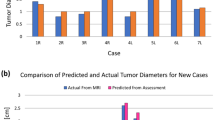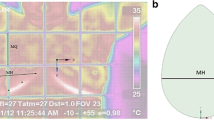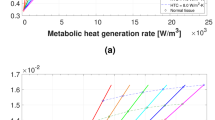Abstract
Breast cancer is the most common cancer among women globally, and the number of young women diagnosed with this disease is gradually increasing over the years. Mammography is the current gold-standard technique although it is known to be less sensitive in detecting tumors in woman with dense breast tissue. Detecting an early-stage tumor in young women is very crucial for better survival chance and treatment. The thermography technique has the capability to provide an additional functional information on physiological changes to mammography by describing thermal and vascular properties of the tissues. Studies on breast thermography have been carried out to improve the accuracy level of the thermography technique in various perspectives. However, the limitation of gathering women affected by cancer in different age groups had necessitated this comprehensive study which is aimed to investigate the effect of different density levels on the surface temperature distribution profile of the breast models. These models, namely extremely dense (ED), heterogeneously dense (HD), scattered fibroglandular (SF), and predominantly fatty (PF), with embedded tumors were developed using the finite element method. A conventional Pennes’ bioheat model was used to perform the numerical simulation on different case studies, and the results obtained were then compared using a hypothesis statistical analysis method to the reference breast model developed previously. The results obtained show that ED, SF, and PF breast models had significant mean differences in surface temperature profile with a p value <0.025, while HD breast model data pair agreed with the null hypothesis formulated due to the comparable tissue composition percentage to the reference model. The findings suggested that various breast density levels should be considered as a contributing factor to the surface thermal distribution profile alteration in both breast cancer detection and analysis when using the thermography technique.





Similar content being viewed by others
References
Agnelli JP, Barrea AA, Turner CV (2011) Tumor location and parameter estimation by thermography. Math Comput Model 53:1527–1534
American Cancer Society (2013) Cancer facts and figures. American Cancer Society, New York
Amri A, Saidane A, Pulko S (2011) Thermal analysis of a three-dimensional breast model with embedded tumour using the transmission line matrix (TLM) method. Comput Biol Med 41:76–86
Anbar M (1994) Hyperthermia of the cancerous breast: analysis of mechanism. Cancer Lett 84:23–29
Arena F, Barone C, DiCicco T (2003) Use of digital infrared imaging in enhanced breast cancer detection and monitoring of the clinical response to treatment. In: Proceedings of 25th Annual International Conference on IEEE Engineering in Medicine and Biology Socirty (IEEE Cat. No. 03CH37439) vol 2
Arora N, Martins D, Ruggerio D, Tousimis E et al (2008) Effectiveness of a noninvasive digital infrared thermal imaging system in the detection of breast cancer. Am J Surg 196:523–526
Balleyguier C, Bidault F, Mathieu MC, Ayadi S et al (2007) BIRADS™ mammography: exercises. Eur J Radiol 61:195–201
Bezerra LA, Oliveira MM, Rolim TL, Conci A et al (2013) Estimation of breast tumor thermal properties using infrared images. Signal Process 93:2851–2863
Borchartt TB, Conci A, Lima RCF, Resmini R, Sanchez A (2013) Breast thermography from an image processing viewpoint: a survey. Signal Process 93:2785–2803
Boyd NF, Byng JW, Jong RA, Fishell EK et al (1995) Quantitative classification of mammographic densities and breast cancer risk: results from the Canadian National Breast Screening Study. J Natl Cancer Inst 87:670–675
Boyd NF, Martin LJ, Sun L, Guo H et al (2006) Body size, mammographic density, and breast cancer risk. Cancer Epidemiol Biomarkers Prev 15:2086–2092
Boyd NF, Guo H, Martin LJ, Sun L et al (2007) Mammographic density and the risk and detection of breast cancer. N Engl J Med 356:227–236
Boyd NF, Martin LJ, Bronskill M, Yaffe MJ et al (2010) Breast tissue composition and susceptibility to breast cancer. J Natl Cancer Inst 102:1224–1237
Checka CM, Chun JE, Schnabel FR, Lee J, Toth H (2012) The relationship of mammographic density and age: implications for breast cancer screening. Am J Roentgenol 198:292–295
Chen MM, Holmes KR (1980) Microvascular contributions in tissue heat transfer. Ann NY Acad Sci 335:137–150
Coleman MP, Quaresma M, Berrino F, Lutz JM et al (2008) Cancer survival in five continents: a worldwide population-based study (CONCORD). Lancet Oncol 9:730–756
Das K, Mishra SC (2013) Estimation of tumor characteristics in a breast tissue with known skin surface temperature. J Therm Biol 38:311–317
Das K, Mishra SC (2014) Non-invasive estimation of size and location of a tumor in a human breast using a curve fitting technique. Int Commun Heat Mass Transf 56:63–70
Das K, Singh R, Mishra SC (2013) Numerical analysis for determination of the presence of a tumor and estimation of its size and location in a tissue. J Therm Biol 38:32–40
de González AB, Reeves G (2005) Mammographic screening before age 50 years in the UK: comparison of the radiation risks with the mortality benefits. Br J Cancer 93:590–596
Dos Santos I, Haemmerich D, Pinheiro CDS, da Rocha AF (2008) Effect of variable heat transfer coefficient on tissue temperature next to a large vessel during radiofrequency tumor ablation. Biomed Eng Online 7:21
EtehadTavakol M, Lucas C, Sadri S, Ng EYK (2010) Analysis of breast thermography using fractal dimension to establish possible difference between malignant and benign patterns. J Healthc Eng 1:27–44
Foster KR (1998) Thermographic detection of breast cancer. IEEE Eng Med Biol Mag 17(6):10–14
Gautherie M (1980) Thermopathology of breast cancer: measurement and analysis. Ann NY Acad Sci 335:383–415
González FJ (2011) Non-invasive estimation of the metabolic heat production of breast tumors using digital infrared imaging. Quant Infrared Thermogr J 8:139–148
Gros C, Gautherie M, Bourjat P (1975) Prognosis and post-therapeutic follow-up of breast cancers by thermography. Bibl Radiol 77–90
Guo Y, Sivaramakrishna R, Lu CC, Suri JS, Laxminarayan S (2006) Breast image registration techniques: a survey. Med Biol Eng Comput 44:15–26
Harvey JA, Bovbjerg VE (2004) Quantitative assessment of mammographic breast density: relationship with breast cancer risk. Radiology 230:29–41
Head JF, Wang F, Lipari CA, Elliott RL (2000) The important role of infrared imaging in breast cancer. IEEE Eng Med Biol Mag 19:52–57
Jiang L, Zhan W, Loew MH (2008) Lector Notes on Computer Science (including Subser. Lect. Notes Artif. Intell. Lect. Notes Bioinformatics), vol 5242 LNCS, pp 798–805
Jiang L, Zhan W, Loew MH (2011) Modeling static and dynamic thermography of the human breast under elastic deformation. Phys Med Biol 56:187–202
Kennedy DA, Lee T, Seely D (2009) A comparative review of thermography as a breast cancer screening technique. Integr Cancer Ther 8:9–16
Kontos M, Wilson R, Fentiman I (2011) Digital infrared thermal imaging (DITI) of breast lesions: sensitivity and specificity of detection of primary breast cancers. Clin Radiol 66:536–539
Kotsianos-Hermle D, Hiltawsky KM, Wirth S, Fischer T et al (2009) Analysis of 107 breast lesions with automated 3D ultrasound and comparison with mammography and manual ultrasound. Eur J Radiol 71:109–115
Lahiri BB, Bagavathiappan S, Jayakumar T, Philip J (2012) Medical applications of infrared thermography: a review. Infrared Phys Technol 55:221–235
Mital M, Pidaparti RM (2008) Breast tumor simulation and parameters estimation using evolutionary algorithms. Model Simul Eng 2008:1–6
Nagao Y, Kawaguchi Y, Sugiyama Y, Saji S, Kashiki Y (2003) Relationship between mammographic density and the risk of breast cancer in Japanese women: a case–control study. Breast Cancer 10:228–233
Ng EYK, Kee EC (2008) Advanced integrated technique in breast cancer thermography. J Med Eng Technol 32:103–114
Ng EYK, Ng WK (2006) Parametric study of the biopotential equation for breast tumour identification using ANOVA and Taguchi method. Med Biol Eng Comput 44:131–139
Ng EYK, Sudharsan NM (2001) Effect of blood flow, tumour and cold stress in a female breast: a novel time-accurate computer simulation. Proc Inst Mech Eng Part H J Eng Med 215:393–404
Ng EYK, Sudharsan NM (2001) An improved three-dimensional direct numerical modelling and thermal analysis of a female breast with tumour. J Eng Med 215:25–37
Ng EYK, Sudharsan NM (2001) Numerical uncertainty and perfusion induced instability in bioheat equation: its importance in thermographic interpretation. J Med Eng Technol 25:222–229
Ng EYK, Sudharsan NM (2004) Computer simulation in conjunction with medical thermography as an adjunct tool for early detection of breast cancer. BMC Cancer 4:17
Ng EYK, Fok SC, Peh YC, Ng FC, Sim LSJ (2002) Computerized detection of breast cancer with artificial intelligence and thermograms. J Med Eng Technol 26:152–157
Ng EYK, Sudharsan NM (2001) Numerical computation as a tool to aid thermographic interpretation. J Med Eng Technol 25:53–60
Nicholson BT, LoRusso AP, Smolkin M, Bovbjerg VE et al (2006) Accuracy of assigned BI-RADS breast density category definitions. Acad Radiol 13:1143–1149
Nilsson AL (1987) Blood flow, temperature, and heat loss of skin exposed to local radiative and convective cooling. J Invest Dermatol 88:586–593
Osman MM, Afify EM (1984) Thermal modeling of the normal woman’s breast. J Biomech Eng 106:123–130
Osman MM, Afify EM (1988) Thermal modeling of the malignant woman’s breast. J Biomech Eng 110:269–276
Pennes HH (1948) Analysis of tissue and arterial blood temperatures in the resting human forearm. J Appl Physiol 85:5–34
Saarenmaa I, Salminen T, Geiger U, Heikkinen P et al (2001) The effect of age and density of the breast on the sensitivity of breast cancer diagnostic by mammography and ultasonography. Breast Cancer Res Treat 67:117–123
Salim MIM, Supriyanto E, Haueisen J, Ariffin I et al (2013) Measurement of bioelectric and acoustic profile of breast tissue using hybrid magnetoacoustic method for cancer detection. Med Biol Eng Comput 51:459–466
Smart CR, Hendrick RE, Rutledge JH, Smith RA (1995) Benefit of mammography screening in women ages 40 to 49 years: current evidence from randomized controlled trials. Cancer 75:1619–1626
Sree SV, Ng EYK, Acharya RU, Faust O (2011) Breast imaging: a survey. World J Clin Oncol 2:171–178
Sudharsan NM, Ng EYK (2000) Parametric optimization for tumour identification: bioheat equation using ANOVA and the Taguchi method. Proc Inst Mech Eng H 214:505–512
Sudharsan N, Ng EYK, Teh SL (1998) Surface temperature distribution of a breast with and without tumour. Comput Methods Biomech Biomed Eng 2:187–199
Sudharsan NM, Ng EYK, Teh SL (2007) Surface temperature distribution of a breast with and without tumour. Comput Methods Biomech Biomed Eng 2:187–199
Tabar L, Fagerberg G, Chen HH, Duffy SW et al (1995) Efficacy of breast cancer screening by age: new results from the Swedish two-county trial. Cancer 75:2507–2517
Umadevi V, Jaipurkar S, Raghavan S (2011) Framework for estimating tumour parameters using thermal imaging. Indian J Med Res 134:725
Vreugdenburg TD, Willis CD, Mundy L, Hiller JE (2013) A systematic review of elastography, electrical impedance scanning, and digital infrared thermography for breast cancer screening and diagnosis. Breast Cancer Res Treat 137:665–676
Werner J, Buse M (1988) Temperature profiles with respect to inhomogeneity and geometry of the human body. J Appl Physiol 65:1110–1118
Zhang S, Gao J (2012) Studying on the thermal conductivity measurement of biological tissues. ECICE 2012, AISC 146:743–749
Acknowledgments
The authors would like to express gratitude to Universiti Teknologi Malaysia for supporting this research under the Institutional Research Grants Vote Number 05H92 entitled “Localization of Tumor using Infrared Imaging Technique for Early Detection of Breast Cancer” and also to the Malaysian Ministry of Higher Education (MOHE) for providing the MyBrain scholarship.
Author information
Authors and Affiliations
Corresponding author
Rights and permissions
About this article
Cite this article
Wahab, A.A., Salim, M.I.M., Ahamat, M.A. et al. Thermal distribution analysis of three-dimensional tumor-embedded breast models with different breast density compositions. Med Biol Eng Comput 54, 1363–1373 (2016). https://doi.org/10.1007/s11517-015-1403-7
Received:
Accepted:
Published:
Issue Date:
DOI: https://doi.org/10.1007/s11517-015-1403-7




